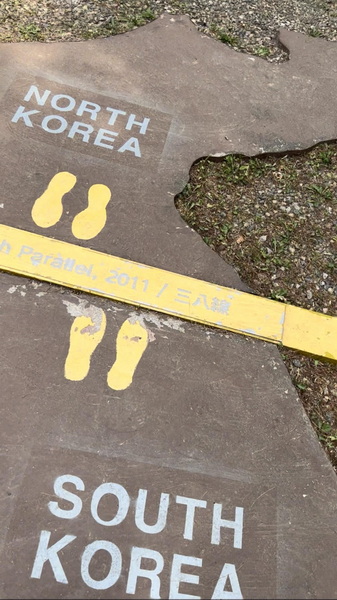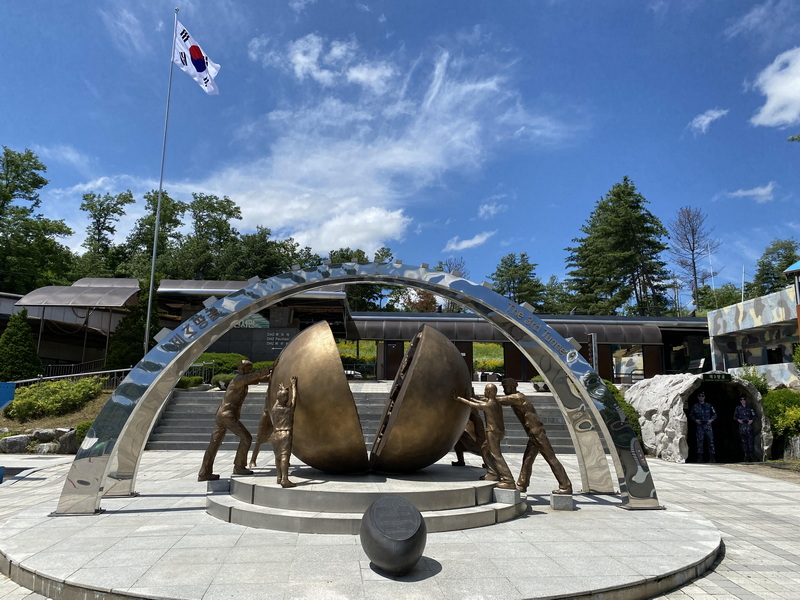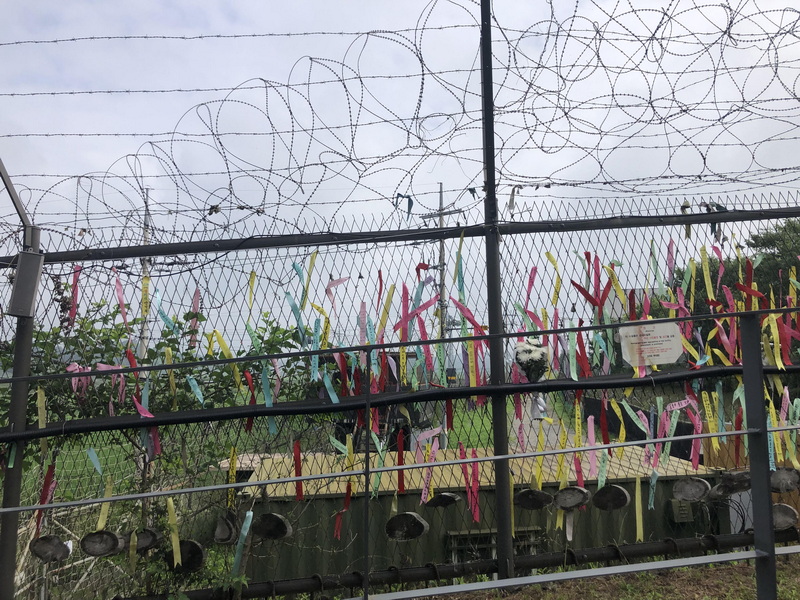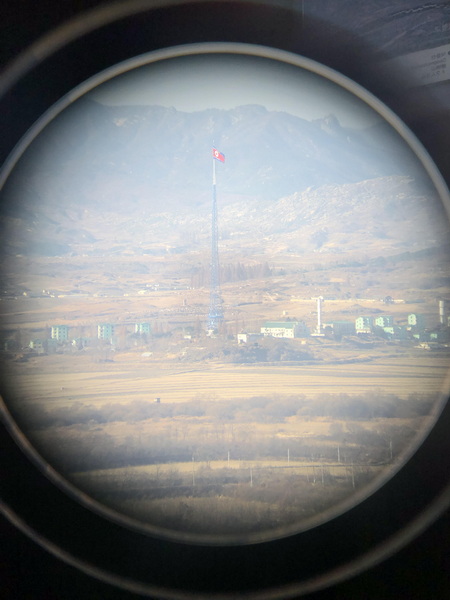On the Frontline: The DMZ
By Ellie Goodwin
What is the DMZ?
In short, the DMZ (Demilitarization Zone) separates North and South Korea. Electrified fencing and landmines flank both sides as well as armed soldiers poised for war. To better understand what brought about the creation of the DMZ, here’s a crude summary of seven decades worth of history in a single paragraph.
Drawn up in 1945, the 38th Parallel was intended to be a temporary division of Korea, north of which Soviet forces would accept a Japanese surrender, with U.S. forces doing the same on the south side. It was hoped that, now liberated, Korea would be ready for self-rule after a time, but the Cold War turned a temporary division into a fixed one. The U.S.-backed Syngman Rhee, and the Soviets turned to Kim Il-Sung. The two men established separate republics: the Republic of Korea (South Korea) and the Democratic People’s Republic of Korea (North Korea). In 1950, after years of conflicts along the border, North Korea launched a surprise invasion that triggered the Korean War. The UN intervened and sent a U.S.-led force to protect the South, driving the North Koreans back to around the 38th Parallel. Soviet troops had long since withdrawn by this point, but aid came to North Korea from China. The Chinese pushed the U.S. forces back to below the 38th Parallel, and a national emergency was declared by President Truman, who feared a third world war. However, by 1951, the fighting had stabilized and truce talks began. Fast forward to 1953: The signing of the an truce between the North Korean and U.S. forces brought an end to the fighting and the establishment of the DMZ.
Why Visit the DMZ?
A trip to the DMZ is a surreal one. It is noted for being one of the most volatile regions in the world but is, simultaneously, a popular tourist attraction. Personally, I cannot think of many other places in the world that have such knife-edge tensions but can still be visited by ordinary civilians. This combination alone makes the whole experience truly unique and worth the visit.
The only way to visit the DMZ is with a guided tour. Normally, I would turn my nose up at this kind of experience, thinking that they’re a money trap, but in regards to the DMZ, I could not have been more wrong. The informative tours are tailored to both history buffs and those interested in learning more about the separation of Korea. My guide’s retelling of the DMZ’s tension-filled past coupled with personal stories of friends who defected from North Korea gave me a deep appreciation for the country’s painful history, the kind that cannot be found in reading a book or watching a documentary. I’ll have to use the exhausted (but accurate) cliché in this instance: history was “brought to life.” And for a decent price.
A few things to bear in mind: Firstly, during my visit, some parts of the tour were not open to visitors, though this may have changed at the time of writing, depending on political tensions. Rather than list all of the sights you may visit on a tension-free day, I’ve given a breakdown of the ones I was permitted to visit. Secondly, what you’ll visit depends on the tour package you buy. Needless to say, more is seen on a full-day package than on a half-day tour.

The Sites
The Joint Security Area (JSA)
Occupied by the South Korean and U.S. military, the JSA is a territory within the DMZ. Located in Panmunjom, it is the closest that a tourist can get to North Korea without being arrested or shot. The iconic blue-painted UN buildings create the image that will come to most people’s minds when thinking about the Korean border: handshakes between Kim Jong Un and President Moon Jae-in and, more recently, President Trump. Here, the world’s longest staring contest takes place: It’s the only spot in the DMZ’s 238-km length where unarmed South and North Korean soldiers face one another. For several years, this cold staring stand-off has been a daily occurrence. Also, when you enter one of these buildings, you’ll have the chance to physically stand in North Korea (even if it’s for a grand total of 5 minutes).
The tour around the JSA is an unsettlingly quiet one. The soldier guide will point out seemingly ordinary spots that are home to memories of violent attacks, the most infamous being the murder of two U.S. soldiers who were hacked to death with axes by North Korean soldiers, as a U.S. work detail attempted to prune a tree that was obscuring a viewpoint.
The Conference Room
This is the room where the 1953 armistice agreement was signed and is also the place where you can cross the demarcation line that divides the room in two. Walking from one side of the Conference Room to the other means that, technically speaking, one has crossed into North Korean territory. I’ll add this to my “countries visited” tally.

Daeseong-dong and Gijeong-dong
With the signing of the Armistice Agreement came the creation of two villages: Daeseong-dong on the southern side and Gijeong-dong on the northern side. Gijeong-dong translates to “Peace Village” but has been renamed “Propaganda Village” by the South because all of the buildings are believed to be empty and uninhabited. Movement in the village is seldom seen, though the village is supposedly home to several hundred families and lights click on and off at the exact same time every day.
The two villages used to have the same rivalries as one may see between neighbors in the suburbs: playing music loudly (propaganda music, no top 40 chart toppers here), and trying to outdo the other by constructing the largest flag (North Korea won this round with its 300-kg flag flying from a 600-meter tower). Both villages can be seen from the viewing point at Panmunjeom.
The Dorasan Observatory
From here, you can look across the border and into North Korea and, if you’re lucky enough to be visiting on a clear day, you can see the bronze statue of Kim Il-Sung in the distance as well as Kaesong city. The ultra-zoom setting on the binoculars allows for a few minutes to be spent peering at North Koreans going about their daily business.

The Third Tunnel of Aggression
The incomplete tunnel was discovered in 1978, after the tunnellers outed themselves by setting off explosives. These explosions detected by the South side and, after four months of searching, the tunnel was discovered. It is believed that the tunnel (which can accommodate 30,000 men) was built with the intent of a surprise attack on Seoul. Like a sibling shifting the blame while being reprimanded by a parent, North Korea hastily denied any responsibility for building the tunnel and pointed the finger at South Korea, insisting that they were culpable. The story then changed when North Korea claimed that the tunnel was part of a coal mine network, though this seems pretty unlikely given that no coal has ever been found in the area. Though the North Koreans went as far as to paint the rocks black to support their coal mine story, it still hasn’t convinced many. Here, you can walk through the tunnel itself, though photography is not permitted.

The Bridge of No Return
Unfortunately, this was not accessible to the public at the time of my visit. Instead, my group and I had to settle for the guide pointing this out to us while we squinted into the distance (me thinking that my glasses needed a stronger prescription as I did). After the Korean War, prisoners between the two sides were exchanged on this bridge. Before crossing, the prisoners were given a choice: remain in the country of their captivity or cross the bridge and return to their homeland. The catch was that prisoners could not change their minds once they made their decision. The name of the bridge aptly describes it all: “no return.”
This concludes the summary of the sites that can be visited during your tour. If you’re fortunate enough to visit on a tension-free day, then you’ll also have a chance to visit other places, too.
Now, down to the less interesting (but important) part detailing things to note before taking a trip to the DMZ. Expect lots of rules thrown your way during your visit, all of which you must adhere to.
Getting There
It’s possible to make your own way there by hopping on the DMZ Peace Train, which runs directly from Seoul. On arrival, you’ll then be transferred onto a bus along with the other DMZ train passengers and taken to the various sites, or you can wait for five hours at the station until the DMZ train returns back to Seoul (can’t imagine why anyone would want to do that, but each to their own).
As mentioned, the only way to visit the DMZ’s civilian-controlled areas is through an organized guided tour, so getting there will depend on which tour company you’ve decided to go with. In my case, the tour company asked that my group and I meet at Gongdeok Subway station in Seoul. From there we took the tour bus (included in the package price), which took us directly to the DMZ.

A Heads-Up Before Your Visit
- You must bring your passport, no photocopies. It will be checked by army personnel at various intervals.
- If you choose to visit the JSA, then you must sign a waiver agreeing that no one is responsible for an accident or injury involving you, or for your death!
- Tours can end unexpectedly or be cancelled at any time if tensions rise at the border.
- There is a dress code that must be followed in the JSA, so ditch the torn and tattered jeans, sleeveless shirts, and military-style outfits. Basically, dress as if you were meeting your significant other’s family for the first time. Interestingly, we were told that the reason for a dress code is owing to reports that North Korea has filmed tourists for propaganda purposes, drawing on tour members’ “dreadful” dress sense to bolster their self-perceived superiority.
- There are strict codes of conduct in place at the JSA. Waving, pointing, or any other signal toward the North Korean guards is forbidden.
- There are strict photograph restrictions in place. Your guide will alert you when you enter a zero photography zone.
The Author
English teacher by trade and keen traveler the rest of the time, Ellie Goodwin has been to 35 different countries, lived in China for over three years, and has been living in Gwangju for as many months. In her free time, she enjoys (you guessed it) traveling, hiking, reading, and the occasional soju. Instagram @elliee_goodwin


